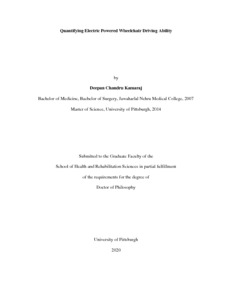Kamaraj, Deepan Chandru
(2021)
Quantifying Electric Powered Wheelchair Driving Ability.
Doctoral Dissertation, University of Pittsburgh.
(Unpublished)
![[img]](http://d-scholarship.pitt.edu/39223/1.hassmallThumbnailVersion/Kamaraj_Dissertation%20Defense_Dec2020_final.pdf)  Preview |
|
PDF (Committee approved version with 166pgs and Abstract at 277 words)
Accepted Version
Download (1MB)
| Preview
|
Abstract
Electric Powered Wheelchairs (EPWs) are complex rehabilitation technology indispensable for independent mobility of people with disabilities. Clinical driving assessments are critical for the provision of EPWs and training EPW users to promote safe mobility. Multiple studies have illustrated that problems with driving EPWs are associated with impairments in motor, sensory and cognitive functions. Existing EPW driving assessment tools provide rehabilitation professionals little insight into the selection of specific training strategies for this key activity based on the users’ impairments. The primary objective of this study is to develop clinical tools to quantify users’ motor, sensory and cognitive impairments that are commonly evaluated during an EPW driving evaluation. The secondary objective is to develop an assistance based scoring system to evaluate EPW driving in the clinic and develop a set of clinically-relevant objective metrics that can serve as an outcome measure of EPW driving evaluation and training.
This motivated the development and content validation of two clinical tools, the Powered Mobility Screening Tool (PMST) and the Powered Mobility Clinical Driving Assessment (PMCDA). A set of objective variables termed Quantitative Driving Metrics (QDM) were developed as digital markers for user’s driving ability. Preliminary psychometric evaluations of these movement-based variables in an EPW driving simulator revealed high stability and construct validity. Content validity of QDM was established through expert interviews. Real-world QDM computed using two modalities (passive motion capture and inertial measurement unit with 9 axis motion sensors) revealed high concurrent validity between the two modalities. A pilot study demonstrated the feasibility of gathering data to compute QDM in a wheelchair clinic. Psychometric evaluation revealed that the PMCDA and QDM have acceptable measurement properties for use in a clinical setting.
Share
| Citation/Export: |
|
| Social Networking: |
|
Details
| Item Type: |
University of Pittsburgh ETD
|
| Status: |
Unpublished |
| Creators/Authors: |
|
| ETD Committee: |
| Title | Member | Email Address | Pitt Username | ORCID |
|---|
| Committee Chair | Cooper, Rory | | | | | Committee CoChair | Dicianno, Brad | | | | | Committee Member | Boninger, Michael | | | | | Committee Member | Schmeler, Mark | | | |
|
| Date: |
21 January 2021 |
| Date Type: |
Publication |
| Defense Date: |
2 July 2020 |
| Approval Date: |
21 January 2021 |
| Submission Date: |
10 June 2020 |
| Access Restriction: |
No restriction; Release the ETD for access worldwide immediately. |
| Number of Pages: |
166 |
| Institution: |
University of Pittsburgh |
| Schools and Programs: |
School of Health and Rehabilitation Sciences > Rehabilitation Science and Technology |
| Degree: |
PhD - Doctor of Philosophy |
| Thesis Type: |
Doctoral Dissertation |
| Refereed: |
Yes |
| Uncontrolled Keywords: |
Electric Powered Mobility, Wheelchairs, Assistive Technology, Digital Health |
| Date Deposited: |
21 Jan 2021 19:53 |
| Last Modified: |
21 Jan 2021 19:53 |
| URI: |
http://d-scholarship.pitt.edu/id/eprint/39223 |
Metrics
Monthly Views for the past 3 years
Plum Analytics
Actions (login required)
 |
View Item |








